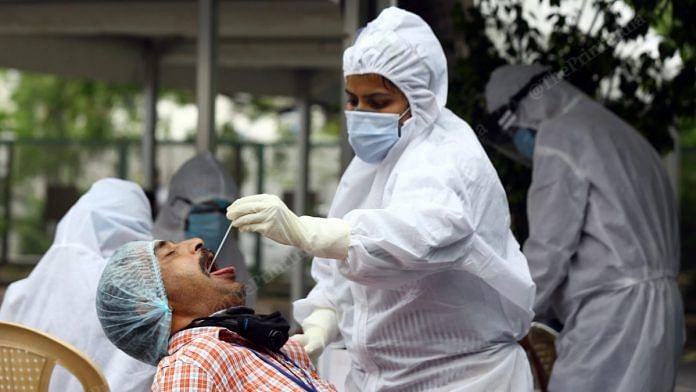There is a word for a newsmaker that is making headlines every day for a whole year. Celebrity. That is why ThePrint’s Newsmaker of the Week this time is no ordinary headline hogger but a bonafide celebrity that has had the entire world on tenterhooks for over a year now and yet manages to stay one step ahead of science.
The SARS-CoV-2 virus, just when it started to seem that India was out of the worst phase, has now come back with a vengeance. The virus, strictly speaking, never really went away — it was lying in wait for an opportunity to strike again and it has now struck. State governments blame it on lax adherence to Covid-19protocol even as elections take place in four states and one Union territory. The Narendra Modi government at the Centre has put the responsibility on the state governments — it now wants 30 contacts to be traced per positive case, up from the earlier 20.
Moreover, the virus has returned in several mutant avatars, at least some of which are more infectious than the original. One month ago, on 26 February, the total number of active cases in India stood at 1,59,590 with 16,488 people testing positive that day. On Friday morning, India reported 59,118 news cases in the preceding 24 hours taking the total number of active cases to 4,21,066. That is a 258 per cent rise in daily new cases and a 163 per cent jump in the number of active cases.
In December last year, the Modi government had put together the Indian SARS-CoV-2 Consortium on Genomics (INSACOG) — a grouping of 10 national laboratories — for carrying out genomic sequencing and analysis of circulating Covid-19 viruses. Since then, out of the total 10,787 positive samples analysed, 771 have been found to have variants of concern, which means the mutation is around the spike protein of the virus. These include 736 samples positive for viruses of the UK variant, 34 for the South African variant and one sample for viruses of the Brazilian strain. These have been identified in 18 states of the country.
Also read: Vaccine cost, hesitancy: What doctors think is sending fewer people to private hospitals
Few lessons learnt
There are similarities with the first Covid wave — just like the last time, the virus seems to have a freer run in some states compared to others. Maharashtra, Madhya Pradesh, Gujarat, and Chhattisgarh are some of the worst-hit currently while Punjab is grappling with double the national average death rate even as cases have increased over four-fold in the last month or so. States are responding with night curfews and weekend lockdowns, even as the Centre says neither work.
Unlike last time, though, there are no testing limitations nor stifling restrictions on who can or cannot get tested. Understanding of the clinical management aspects has evolved and doctors are now relying more on oxygen, low-cost steroids, and Vitamin C and Zinc supplements rather than clamouring for ventilators.
But other kinds of limitations remain. For example, the much-vaunted INSACOG is struggling to return genome analysis results on time. Such was the waiting period for Punjab, which was earlier sending samples to the National Institute of Virology in Pune and the Institute of Genomics and Integrative Biology in New Delhi, that the National Centre for Disease Control was forced to run a batch analysis just for samples from the state. It was done to clear the backlog in the state. The results were astounding — 81 per cent of the 401 samples tested were positive for the new UK variant of the coronavirus.
But the biggest change that has happened since the last wave is that we now have a very real shot at achieving herd immunity. The vaccination programme that kicked off on 16 January had come with a lot of expectations but has since fallen short on many counts. Apart from an occasional “record” effort of 35 lakh vaccine doses administered, the daily vaccination report card has hovered in the 20 lakh range on an average, falling to a fifth of that on Sundays.
Celebrity that it is, SARS-CoV2 does not take weekend breaks but our vaccinators need theirs.
Also read: Night curfew in Maharashtra from 28 March as Covid cases rise
Back to red tape
Some estimates suggest that at this rate — and with India planning to open up vaccinations for all above 45 years from 1 April — it could take India several years to vaccinate even this limited population. The Modi government has made it clear multiple times that it is not in favour of vaccination for all.
Somewhat inexplicably, in a throwback to the ‘inspector raj’ of yore, the vaccination programme and the marketing of vaccines is all tightly controlled by the central government. Not only can an average citizen not buy vaccines from the market unless they meet the government’s “eligibility” criteria, even states cannot procure vaccines on their own. That is why allegations of vaccine shortage keep resurfacing, especially in poll-bound states. It is only now that a decision has been taken to restrict exports and cater to domestic demand.
During the first Covid-19 wave, epidemiologists had accused the government of listening to modelers and bureaucrats in deciding the Covid-19 strategy. Now it is the same bureaucratic control over vaccinations that seem to be pulling down India’s best chances against a resurgent virus. In the last one year, it has proved itself to be a canny practitioner of the evolution principle of “survival of the fittest”.
Being just as nimble is humankind’s only chance against it.
Views are personal.
(Edited by Prashant Dixit)







Over centralisation. Micro management. Part of the same pattern of governance, across all domains. The virus is improving, mutating, getting smarter all the time. Nature is on its side. Perhaps our decision makers should learn some useful life lessons from it.